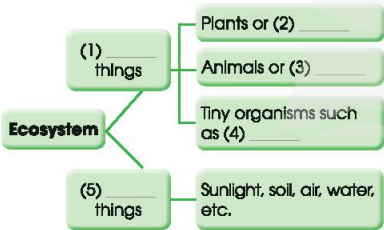Câu hỏi:
56 lượt xemUse the words in the box to form compound nouns mentioned in 1. Match them with the meanings below.
(Sử dụng các từ trong hộp để tạo thành các danh từ ghép được đề cập trong phần 1. Nối chúng với các nghĩa bên dưới.)
|
raw |
climate |
change |
resources |
|
park |
natural |
national |
materials |
|
1. a change in the earth's weather conditions |
__________ |
|
2. things that exist in nature and can be used by people |
__________ |
|
3. land protected by the government because of its natural beauty or special history |
__________ |
|
4. basic materials used to make products |
__________ |
Lời giải
Hướng dẫn giải:
raw (adj): thô
climate (n): khí hậu
change (n): thay đổi
resources (n): tài nguyên
park (n): công viên
natural (adj): thuộc về tự nhiên
national (adj): thuộc về quốc gia
materials (n): nguyên liệu/ vật chất
Lời giải chi tiết:
|
1 - climate change |
2 - nutural resources |
3 - national park |
4 - raw materials |
1. a change in the earth's weather conditions = climate change
(sự thay đổi điều kiện thời tiết của trái đất = biến đổi khí hậu)
2. things that exist in nature and can be used by people = natural resources
(những thứ tồn tại trong tự nhiên và con người có thể sử dụng = tài nguyên thiên nhiên)
3. land protected by the government because of its natural beauty or special history = national park
(vùng đất được chính phủ bảo vệ vì vẻ đẹp tự nhiên hoặc lịch sử đặc biệt = công viên quốc gia/ vườn quốc gia)
4. basic materials used to make products = raw materials
(nguyên vật liệu cơ bản làm nên sản phẩm = nguyên liệu thô)
Ecosystems and humans
(Hệ sinh thái và con người)
Listen and read.
(Nghe và đọc.)
Ms Hoa: Nam, you went to Cuc Phuong National Park last weekend, didn‘t you?
Nam: Yes, that’s right. It was an amazing trip. This old forest is home to thousands of different kind of plants, insects, and animals. I really liked the colourful butterflies and the thousand-year-old tree.
Ms Hoa: Yes, Cuc Phuong National Park has a very rich ecosystem.
Mai: What's an ecosystem, Ms Hoa?
Ms Hoa: It's a community that has living things, like flora and fauna. Flora refers to plants and fauna refers to animals, including tiny organisms, like bacteria. Ecosystems also include non-living things, like sunlight, air, soil, and water.
Nam: How important are ecosystems to life on our planet, Ms Hoa?
Ms Hoa: Healthy ecosystems are essential for human health and survival because they provide us with goods such as food, energy, raw materials, clean water, and air.
Mai: So we should protect our ecosystems, shouldn't we?
Ms Hoa: That's right. Unfortunately, many ecosystems around the world are being lost, damaged, or destroyed because of climate change, pollution, and overuse of natural resources. It’s very important to protect and restore them for future generations. We don't want our planet to lose even more biodiversity, do we?
Read the conversation again and decide whether these statements are true (T) or false (F).
(Đọc đoạn hội thoại một lần nữa và quyết định xem những câu này là đúng (T) hay sai (F).)
|
|
T |
F |
|
1. Nam went to Cuc Phuong National Park two weeks ago. |
|
|
|
2. In an ecosystem, plants, animals, and other living and non-living things form a community. |
|
|
|
3. We are losing a large number of ecosystems around the world. |
|
Complete the diagram with words in 1.
(Hoàn thành sơ đồ với các từ trong 1.)

